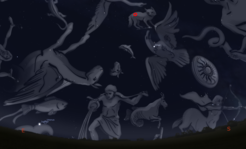Second discovery with Einstein@Home
J1952+2630 - a neutron star with a binary companion

Neutron stars are exotic objects. They consist of material that is much denser than normal matter; at similar densities the entire mass of the earth would form a ball about 260 m in diameter. Neutron stars spin quickly, sending out radiation like a lighthouse. They are most often visible as radio pulsars. Working with the PALFA Collaboration, researchers under the direction of Prof. Bruce Allen at the Max Planck Institute for Gravitational Physics in Hannover have discovered a new pulsar. It pulses 48 times per second, and appears to be orbiting a white dwarf star with almost the same mass as the Sun. Without the participation of Einstein@Home volunteers like Dr. Vitaly V. Shiryaev (Moscow, Russia) and Stacey Eastham (Darwen, UK) this binary star system, which has an orbital period of 9.4 hours, would have escaped detection.
This is because interesting astrophysical objects, like this neutron star, can only be "extracted from the data" with great effort. For this reason, researchers have gotten help with their demanding data analysis problems from the general public, who volunteer the unused computing power of their home or office computers for Einstein@Home. Einstein@Home is one of the world's largest distributed computing projects, with more than 280,000 participants. About 35% of its available computing power is being used to search radio telescope data, including data from the PALFA Collaboration. The Pulsar ALFA (PALFA) Collaboration was formed in 2003, with the goal of carrying out a large-scale search for new pulsars with the Arecibo Telescope. It has members from 20 Universities, Research Institutes and Observatories world-wide.
The Einstein@Home participants whose computers detected the new pulsar with the highest significance, Shiryaev and Eastham, are acknowledged by name in the paper.
The paper itself has been submitted for publication to the Astrophysical Journal.












